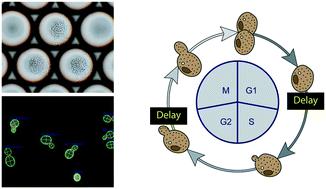Our official English website, www.x-mol.net, welcomes your
feedback! (Note: you will need to create a separate account there.)
Are droplets really suitable for single-cell analysis? A case study on yeast in droplets
Lab on a Chip ( IF 6.1 ) Pub Date : 2021-08-09 , DOI: 10.1039/d1lc00469g Yuta Nakagawa 1 , Shinsuke Ohnuki 2 , Naoko Kondo 2 , Kaori Itto-Nakama 2 , Farzan Ghanegolmohammadi 2 , Akihiro Isozaki 1 , Yoshikazu Ohya 2, 3 , Keisuke Goda 1, 4, 5
Lab on a Chip ( IF 6.1 ) Pub Date : 2021-08-09 , DOI: 10.1039/d1lc00469g Yuta Nakagawa 1 , Shinsuke Ohnuki 2 , Naoko Kondo 2 , Kaori Itto-Nakama 2 , Farzan Ghanegolmohammadi 2 , Akihiro Isozaki 1 , Yoshikazu Ohya 2, 3 , Keisuke Goda 1, 4, 5
Affiliation

|
Single-cell analysis has become one of the main cornerstones of biotechnology, inspiring the advent of various microfluidic compartments for cell cultivation such as microwells, microtrappers, microcapillaries, and droplets. A fundamental assumption for using such microfluidic compartments is that unintended stress or harm to cells derived from the microenvironments is insignificant, which is a crucial condition for carrying out unbiased single-cell studies. Despite the significance of this assumption, simple viability or growth tests have overwhelmingly been the assay of choice for evaluating culture conditions while empirical studies on the sub-lethal effect on cellular functions have been insufficient in many cases. In this work, we assessed the effect of culturing cells in droplets on the cellular function using yeast morphology as an indicator. Quantitative morphological analysis using CalMorph, an image-analysis program, demonstrated that cells cultured in flasks, large droplets, and small droplets significantly differed morphologically. From these differences, we identified that the cell cycle was delayed in droplets during the G1 phase and during the process of bud growth likely due to the checkpoint mechanism and impaired mitochondrial function, respectively. Furthermore, comparing small and large droplets, cells cultured in large droplets were morphologically more similar to those cultured in a flask, highlighting the advantage of increasing the droplet size. These results highlight a potential source of bias in cell analysis using droplets and reinforce the significance of assessing culture conditions of microfluidic cultivation methods for specific study cases.
中文翻译:

液滴真的适合单细胞分析吗?液滴中酵母的案例研究
单细胞分析已成为生物技术的主要基石之一,激发了用于细胞培养的各种微流体隔室的出现,例如微孔、微捕获器、微毛细管和液滴。使用这种微流体隔室的一个基本假设是,来自微环境的细胞的意外压力或伤害是微不足道的,这是进行无偏见单细胞研究的关键条件。尽管这个假设很重要,但简单的生存力或生长测试绝大多数是评估培养条件的选择,而对细胞功能的亚致死效应的实证研究在许多情况下是不够的。在这项工作中,我们使用酵母形态作为指标评估了在液滴中培养细胞对细胞功能的影响。使用 CalMorph(一种图像分析程序)进行的定量形态学分析表明,在烧瓶、大液滴和小液滴中培养的细胞在形态上存在显着差异。从这些差异中,我们确定细胞周期在 G1 期和芽生长过程中的液滴延迟,可能分别是由于检查点机制和线粒体功能受损。此外,比较小液滴和大液滴,大液滴中培养的细胞在形态上与烧瓶中培养的细胞更相似,突出了增加液滴大小的优势。
更新日期:2021-08-19
中文翻译:

液滴真的适合单细胞分析吗?液滴中酵母的案例研究
单细胞分析已成为生物技术的主要基石之一,激发了用于细胞培养的各种微流体隔室的出现,例如微孔、微捕获器、微毛细管和液滴。使用这种微流体隔室的一个基本假设是,来自微环境的细胞的意外压力或伤害是微不足道的,这是进行无偏见单细胞研究的关键条件。尽管这个假设很重要,但简单的生存力或生长测试绝大多数是评估培养条件的选择,而对细胞功能的亚致死效应的实证研究在许多情况下是不够的。在这项工作中,我们使用酵母形态作为指标评估了在液滴中培养细胞对细胞功能的影响。使用 CalMorph(一种图像分析程序)进行的定量形态学分析表明,在烧瓶、大液滴和小液滴中培养的细胞在形态上存在显着差异。从这些差异中,我们确定细胞周期在 G1 期和芽生长过程中的液滴延迟,可能分别是由于检查点机制和线粒体功能受损。此外,比较小液滴和大液滴,大液滴中培养的细胞在形态上与烧瓶中培养的细胞更相似,突出了增加液滴大小的优势。











































 京公网安备 11010802027423号
京公网安备 11010802027423号